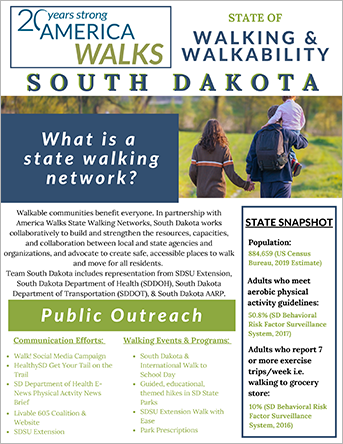Creating activity-friendly routes to everyday destinations is an evidence-based strategy used to improve walkability and increase physical activity. Encouraging active transportation – walking or biking daily to daily destinations such as work, school or a park for example, helps residents to get more physical activity. It’s a great way to improve public health and prevent chronic disease.
Many South Dakota communities have taken steps to create more walkable neighborhoods and connect places and spaces for all people to walk, roll, or bike to.
There are many ways to improve infrastructure and the ideas for creating safe places for people to be active are almost endless—but the process is similar. Active transportation advocates usually follow these steps:
- Find your leaders and gather partners
The best teams are made up of people from all areas in the community including: city or county officials, Tribal Council members, planning district and parks and recreation representatives, wellness or physical activity champions, business leaders, public health and healthcare officials, law enforcement, community coalitions, schools, service groups, older adults, people with disabilities, chamber of commerce members, and many others. - Identify community needs
This is where your active transportation team can have some fun with ideas and identify long and short-term goals for your community. Start by answering questions like:- How can we encourage mixed land use and greater land density to shorten distances between homes, workplaces, schools, and recreation so people can walk or bike more easily to them?
- What would it take to build strong pedestrian and bicycle infrastructures like bike racks, sidewalks, and safe bike paths?
- How can we create community gathering places and destinations so residents have a place to walk to as part of their daily activities?
- How can we increase availability and access to green space and parks?
- Conduct assessments
Active transportation in small, rural, and remote communities may look different than in larger areas. Rural communities may also need to create active recreation opportunities even if residents must drive to them. Start with easy, doable tasks to establish overall needs and priorities.
South Dakota Communities Collaborate with SDSU-Landscape Architecture to Create Active Transportation Planning Blueprints
Download these SDSU-LA Community Reports to find out how communities in your area are planning to improve their neighborhoods.
- Burke (PDF)
- Box Elder (PDF)
- Crooks (PDF)
- Ft. Pierre (PDF)
- Hot Springs (PDF)
- Huron (PDF)
- Misson (PDF)
- Mitchell (PDF)
- Salem (PDF)
- Sioux Falls and Harrisburg (PDF)
- Sturgis (PDF)
- Tripp (PDF)
- Volga (PDF)
- Wanblee (PDF)
Additional Tools to Help You Get Started
Ready to start creating activity-friendly routes in your community?
Check out the Active Transportation Checklist for a guide on how to start.
Get involved with the South Dakota State Walking Network.
Take advantage of the Active Transportation Assessment Collaboration grant opportunity that can aid your community with technical assistance in conducting active transportation assessments and providing recommendations for improving your environment!

